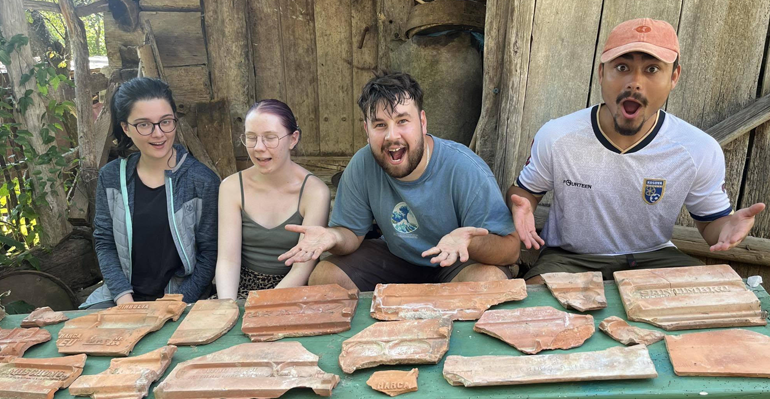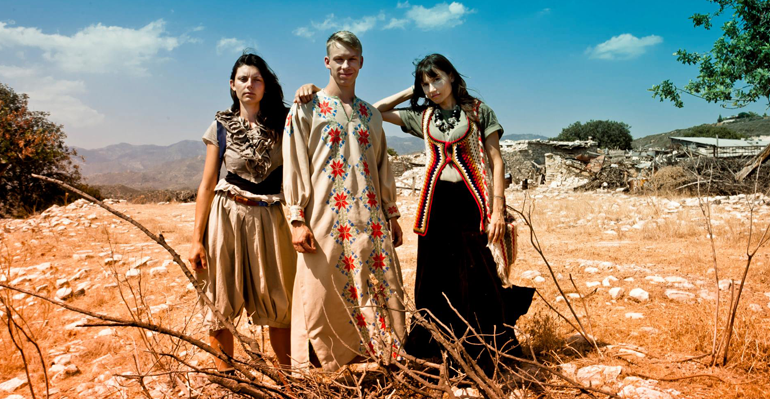
What the Romans did for us. Zoomorphism in the ancient context and how it transferred to ceramic roof tiles, in countries once in the Roman Empire.
Introduction:
So much of European culture is already well known and is ‘re-packaged’; it is rare indeed to discover new information about culture. In 2012 this is exactly what happened here in Cyprus with Kato Drys Community Council and partners, when a visiting French student turned over a broken terracotta ‘interlocking’ roof tile and saw a crisp and clear logo of a butterfly. The roof tile story began right then and there and now we have discovered almost 200 rooftiles with ‘zoomorphic’ logos.
As archaeological practitioners, we surmised (with help from Roman experts) that the habit was from the glory days of the Roman Empire and linked to ‘Samianware’, an early example of industrial ceramics. We have drawn together many threads in our rooftile discoveries and the European Union was lavish in its praise because it was ’new stuff’.
Now you can come to Cyprus to share in our discoveries and maybe even find more animals, birds, insects and reptiles on old roof tiles, as well as learn about some early examples of industrial espionage and fights for market domination in Europe and the Levant (and spreading to Australia, New Zealand and the USA), with France and Romania being the main protagonists.
This “Roof Tile Heritage Trail” in Larnaca district is offered by Kato Drys Community Council and their stakeholders, Mola Culture Factory. It links to opportunities to learn some cool recycling ideas, such as making unique jewellery. Find the link to the map of the trail below, or contact the Mola Culture Factory for more details.
What you'll discover:
Athasi Heights, base of Grampus Heritage South East Europe
At stop one, you will see examples of zoomorphic rooftile logos gathered from all over Europe and hear the story of how they are linked.
The Chapel of Archangel Michael
At stop two, you will visit the Chapel of Archangel Michael, located in Kato Lefkara, 2 kilometres from the Athasi Heights, with its intact Byzantine roof.
Skarino
Stop three is 10 kilometres away from Kato Lefkara. Here you can visit an abandoned builders’ storage yard full of ceramic terracotta roof tiles, some over 120 years old.
Kato Drys
Stop four leads you to Kato Drys where you will visit 2 sites and discover old rooftiles from far-flung islands and the Greek mainland – why did they come here?
Pano Lefkara
Stop five brings you back to Pano Lefkara. We return to the carpark of the Holy Cross Church and sort through piles of old tiles on the terrace below to discover the ‘French Connection’ and how, for a time, ‘Marseilles’ roof tiles dominated.
Why this trail matters:
- The stories and the experience will help to stimulate the local economy in a sustainable way.
- Visitors will learn more about the local cultural landscape that few tourists see.
- Discovery by tourists, from Cyprus and abroad, will raise awareness of the need for recognition and protection of vernacular patrimony, as it applies to architecture and especially roof tiles.
- The experience will help visitors recognise links that go back to the Roman Empire and reconnections during the period of the industrial revolution.
- Visitors will learn something that is genuinely ‘new’ – for our research work, we received a commendation from the EU.
- Together we can see how rooftiles stimulate ideas about fashion design and can be re-purposed for art and craft.
Heritage Trail Map:
Heritage Trail Details:
- Length (km): 32 km
- How it could be undertaken: driving; can be undertaken alone but Mola can provide a guide.
- Special notes (clothes, equipment, weather, etc.): Between the end of October and the end of March, rain is possible and a light raincoat is needed plus a warmer jumper of fleece. At all times wear a hat, even in winter the sun can burn and in Spring, Summer and Autumn, sunburn is commonplace. You should also wear sun cream of over factor 40, especially if not between end of October and end of March. If walking you need strong shoes with good ankle protection. Do not walk into the ‘maquis’; it is prickly and unyielding.
- Safety guidelines: Follow the rules about clothing and staying on the track. Cyprus has a few quite dangerous examples of wildlife but injuries are extremely rare. There is one very venomous snake, a blunt-nosed viper. Snakes lay in the sun to warm up, you spot them on the track; stamp your feet and they slither away. A black whipsnake is common and is not venomous. None of the 6 types of lizards that you might see, are any problem. Do not randomly turn over stones because there are venomous centipedes and scorpions but their bite is not worse than a bee sting. Do not walk off into the maquis, in case you come suddenly upon a snake. All in all, the wildlife is fascinating and if you take care, is not a threat.
- Guiding:
- This trail can be completed alone, or with a guide.
- To book a guide, please contact The Old Olive Mill – Mola Culture Factory
Contacts for more details:
Mola Culture Factory
https://www.facebook.com/molalefkara/
Address: Saint Onoforus 1, Pano Lefkara, 7700, Larnaca District, Cyprus
Phone: +357 99739320
Email: martinclark6@aol.com
Quests / Chances to be creative:
Because Kato Drys Community and its stakeholders promote traditional skills and creativity, we use the opportunity given by the trail, to offer some short courses. They are held over 2 days; after completion of the trail. The KDCC/Mola team will source accommodation and recommend restaurants, etc. In this way KDCC is trying to help the local village economies (of Kato Drys and Pano Lefkara). These courses are optional but should be booked at the time of booking a guide for the trail. Although the trail can be completed alone and the stories heard over a smartphone, we recommend booking through our stakeholder, The Old Olive Mill – Mola Culture Factory (+357 99739320).
Quest 1: 'Covering a ‘Greek Oven'
Covering a ‘Greek Oven’ with hexagonal cut bee motives from the Limassol Brick and Tile Company. Such tiles are common, so we are not using rare cultural resources. The finish is decorative but also helps to insulate the oven and keep the heat in for cooking such meals as ‘Kleftiko’ (lamb and potatoes).
Quest 2: 'Making zoomorphic roof tile jewellery'
Making zoomorphic roof tile jewellery using cut up tiles: one of our technicians will pre-cut to make pendants and beads. If there are special ideas, the technician is there on the day to cut special shapes. By the way, tile cutting produces a fine red ochre/ terracotta/ sienna dust that we save for pigment painting. The participant also learns how to make cordage from a variety of natural plant fibres.


